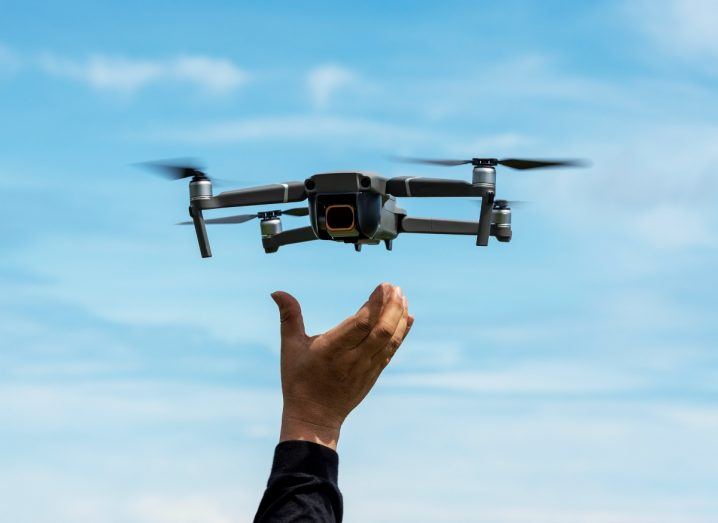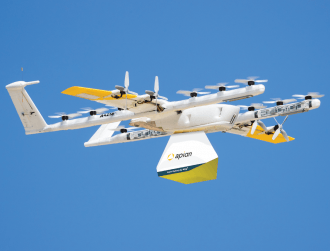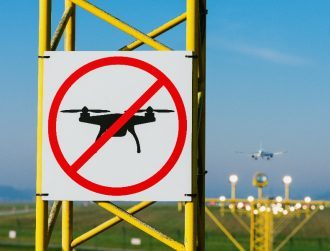
Image: © cn0ra/Stock.adobe.com
From food deliveries and agricultural monitoring to futuristic air taxis, Ireland is becoming a haven for drone technologies from home and abroad.
For most people who grew up in the last century, the idea of a sky pervaded with drones carrying everything from food to medicines might seem to belong to the realms of science fiction. Fast forward to the 21st century and now the tech has well and truly taken off – with Ireland playing a leading role in regulating this burgeoning space.
Only last week, Irish drone delivery wunderkind Manna revealed it is all set to begin what founder and CEO Bobby Healy calls “the biggest drone delivery operation in the world” in Dublin’s Blanchardstown neighbourhood. This follows the start-up’s many pilot successes across the country, most notably in Balbriggan, where it has been delivering food and other products to a 35,000-strong community.
“I really love to see Irish companies like Manna growing at home and then going global,” Taoiseach Leo Varadkar, TD, said in March during his St Patrick’s Day visit to Washington DC, where Manna announced its first US drone trial was taking flight in the Dallas-Fort Worth area of Texas.
With an impressive array of feathers in his cap since Manna launched in 2019, Healy now has his eyes set on further expansion in the EU. The entrepreneur plans to expand into continental Europe with at least two launches being discussed for next year – and much of that decision has to do with the ease of doing business on the continent.
“What Europe does really well, is regulation. It’s kind of a heavy regulation market, from drones to AI to consumer tech, it’s very active at regulation. And while sometimes that can be a bad thing, in the case of aviation we can’t have an industry or business without strong regulations, because it’s physical,” Healy says.
“We’re all flying through each other’s airspace, and we’re mixing with general aviation. You can’t even start until you have the clear, concise and practical regulation. And that’s exactly what Europe has done. There’s no compromising on safety – and it’s at least three years ahead of the US at this stage.”
And within the EU, Ireland has stood out for its response to the needs of the drone industry with its “pro-business” attitude. “If we were from Lithuania, Poland or wherever, as a company, Ireland would still be where we’d be operating because it’s got everything we need,” he adds.
A risk-based approach to drone regulation
As Ireland is having its golden hour in drone technology, the importance of regulating drones cannot be underestimated. Earlier this year, illegal drones flying in the proximity of Dublin Airport caused successive and severe disruptions, leaving airport authorities scrambling to reroute flights and hundreds of passengers delayed. Famously, London’s Gatwick faced the same issue five years ago.
“Drones causing disruptions at airports and events is a statewide issue that needs to be tackled with new legislation, a state agency responsible for managing counter drone technology and harsher sentences,” Dublin Airport said in March, following its sixth disruption since January.
Ryanair CEO Michael O’Leary even called on Minister for Transport Eamon Ryan, TD, to give DAA, the company that operates Dublin Airport, the authority to bring down the drones themselves.
“We need to make sure we get the right equipment and get the best defensive capability and make sure we do it in a way that protects passengers, protects people living close to the airport and that we have the ability to prosecute people who are then caught and punish them accordingly,” Ryan responded at the time.
Enda Walsh, who manages the unmanned aircraft systems division of the Irish Aviation Authority (IAA), says that flying and operating drones in Ireland is subject to EU regulation that dates back to 2019.
Other than supervising and implementing said regulation in Ireland, the IAA also provides guidance on flying drones to ensure public safety. According its website, any person flying a drone that weighs more than 250g or has a camera or sensor needs to register as a drone operator.
“European regulation takes a fully risk-based approach to drones. We don’t really differentiate between commercial or recreational drones, and they fall under three broad categories: open, specific and certified,” said Walsh.
Drones under the ‘open’ category are considered “lower risk” and must weigh below 25kg, always be in the visual line of sight and stay below 120 metres or 400 feet above ground or water.
“The reason for that is most general aviation is required to fly 500 feet above the surface of the Earth, so it gets that kind of buffer on us. A lot of these drones would be the ones you buy at Curry’s or Harvey Norman such as the DJI ones.”
The ‘specific’ category is for drones that travel beyond the line of sight for activities such as deliveries or inspection of power lines and gas pipelines. And finally, the ‘certified’ category comprises drones that are considered “high risk”.
“This will include things like air taxis, the carriage of people or international cargo flights without pilots. Basically big, big drones that would be treated very much like manned aviation,” Walsh explains. “There’s no real certified drone operations yet, that element of regulation is in development – but they’re coming very quickly.”
More applications on the horizon
While regulation for crewed drones is swiftly drafted by on-the-ball EU authorities, companies such as Dublin-based Avolon and LCI already have the ball rolling on electric vertical take-off and landing (eVTOL) aircraft that can carry humans or transport cargo commercially.
The aircraft leasing firms have been ordering eVTOLs this year to take drone operations in Ireland to new heights in the near future, pending legislation.
Meanwhile, Canadian tech company ZenaDrone, which has operations in Ireland, is developing drones for applications in agriculture by combining AI algorithms with sensor technology. This can help the machines to map and monitor fields for various metrics, such as crop yield, underperforming areas and locating crop disease.
But the real charm of ZenaDrone’s uncrewed aircraft lies in their ability to be customised for different purposes.
“Our drone is a large piece of equipment, three by two meters, and it’s designed as a multifunctional platform. This means that it’s not only for one use but can be customised, unlike other drones in the market, depending on the end user or the industry,” says ZenaDrone business development manager Simon Henry.
“Ireland was identified as a great place to start for agriculture, because of the abundance of different crops and livestock to manage as well as a shortage in the labour force where our drones can step in.
“Farmers are also under more pressure to produce higher yields, while there’s a lot of different types of diseases affecting plantation.”
Fitted with sensors and cameras, ZenaDrone’s machines can identify the diseases at “the earliest point possible” before human eyes can detect them, Henry claims. The incentive is that the Government has been pushing for a reduction in reliance on pesticides and fertilisers.
“Once it maps out the area of disease, the drone goes back, puts on its spraying attachment and returns to the affected area to spot spray individual pieces of land rather than the farmer having to spray the whole land. But the farmer doesn’t have to buy the drone, we lease it to them.”
An attractive ecosystem for drones
As an international company with operations in Ireland, ZenaDrone has some experience in navigating the many intricacies in regulation across different markets, including Canada, the US, the EU and, most recently, Dubai – where it has a testing facility for safety.
But complying with regulations in Ireland has been, by far, the easiest, according to ZenaDrone engineer Dhairya Bhatt, who has been liaising with different Government departments and other stakeholders internationally to ensure minimal turbulence for the company’s drones.
“EU rules around drones are very easy to understand compared to the US, where regulations made by the FAA [Federal Aviation Authority] are way more strict, complex and non-practical, like something that you can’t achieve,” Bhatt tells me.
“They have more loopholes compared to the EU, where regulation is straightforward and there are clear categories for different types of drones based on weight, size, speed, line of sight and other parameters that make it easier to develop the right kinds of drones for the market.”
It’s safe to say, therefore, that parts of Ireland’s skies, especially outside the big cities, will soon be abuzz with drones carrying everything from deliveries and emergency medicines to even people. Companies benefiting from the foresight of Irish authorities are, in turn, helping improve the regulation by providing constant feedback – creating an ecosystem that can attract other companies.
Google-backed Wing, for example, landed in the Irish market last year with its drone delivery services. It competes in the same category as Manna and is currently testing its technology in the Lusk area of north Dublin.
While most others would be worried about losing out on market share, Healy not only welcomes some competition, but hails Wing as “the gold standard in our industry”.
“They have a platform that’s way ahead of everyone, a team that has the ability and capital to really go forward and they’re ready to scale,” he says. “They’ll be held back in the US, just because regulations aren’t there yet. But I think you can safely say that it will be Manna and Wing scaling in Europe in the not-too-distant future.”
10 things you need to know direct to your inbox every weekday. Sign up for the Daily Brief, Silicon Republic’s digest of essential sci-tech news.






